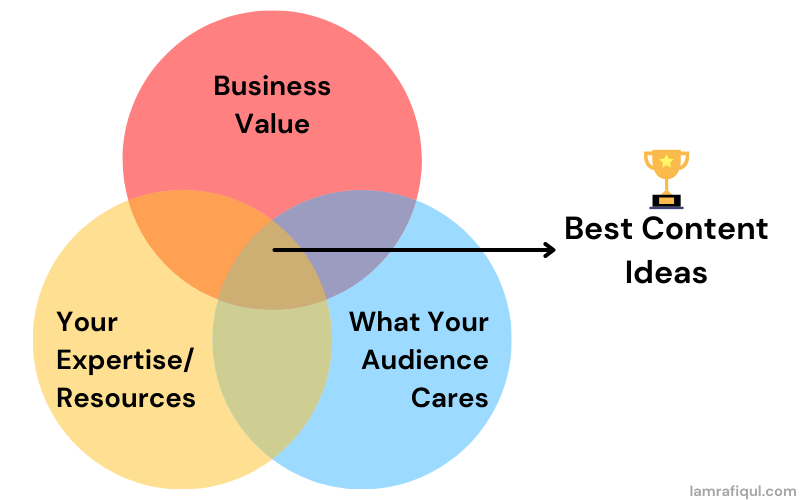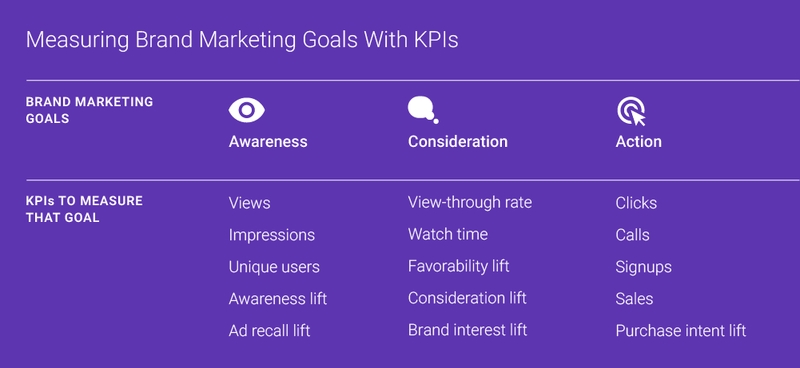What do you prefer? Reading a 1000 word blog post or a 10-minute video?
If you are one of the 69 percent of people in the world surveyed in a recent report of Wyzowl, chances are you prefer the latter. Video marketing will account for 82% of global internet traffic by 2022, According to Oberlo. And the reasons are many such as:
- High conversion rate
- High ROI,
- Increased engagement by the target audience
- Brand awareness, and so on.
But like any other marketing method, you cannot risk going in blind. Read this guide to creating a video-first content marketing strategy below and prepare to watch your content blow up like never before.
Here is a step-by-step process to develop your video content marketing strategy:
Quick Navigation
- Identify Your Video Marketing Goals
- Research Your Audience
- Create Videos Tailor-Made for Your Audience
- Allocate Budget For Video Production
- Identify Video Hosting Platform
- Measure Video Performance
- Bonus Video Content Marketing Tips
1. Identify Your Video Marketing Goals
Before jumping into the video content marketing strategy, you need to have a plan backed by solid goals. What’s your larger goal for your marketing methods? Do you want to generate more leads for your business? Expand your email list? Or build brand awareness. Knowing your exact goals will also help track the success of your video marketing methods down the road.
Having clear and measurable goals also helps build a tailor-made plan to achieve them.
Let us say your goal is to build brand awareness. You have a specific vision for your brand that must be communicated through a 5-minute video.
What do you do?
You may use free editing software to add fun graphics and background music to optimize your videos and create an instant impression. You then take forward this strategy across all your videos. When customers view your videos, they look at the logos, the style, the music and instantly identify the video with your brand. Over time, this results in brand awareness.
Let us look at a different goal. You want to grow your email list. What do you do? You create top-of-the-funnel marketing videos that are extremely targeted and informative. Consumers can watch your videos for an instant solution to a problem.
Next, you can share these videos in a social media post, directing viewers to a landing page on your website. From there on, you can add more prompts like signing for a newsletter for a freebie, monthly informational content, etc.
And viola-you have added a new customer to your list.
2. Research Your Audience
Once you have your goal in hand, you can then begin the process of researching your potential customer. Your ideal customer and target audience will have a bearing on the topic of your videos, the music, the length, even the kind of content you create. An easy way to start crafting your buyer persona is by conducting a quick online survey.
Ask open-ended questions and make the survey comprehensive. You can even research your competitor to see the content they are creating.
Check out the stats of their videos, their customer demographics, the accounts they are following, etc. And craft your videos around them. Spending some time creating and perfecting your buyer persona will reap big dividends in the long run. Over 71% of companies who exceed revenue and lead goals have created Buyer Personas, and 47% of companies who exceeded sales and revenue goals maintain their Personas over time, According to a report by MadMarketer.
A younger audience will likely not have the patience to sit through a lengthy 12-minute informational video. When it comes to catching their attention, you’ll need to think of an instant hook or a video that is less blatant sales. According to Vidyard, 56% of all videos published in 2020 were less than 2 minutes long.
3. Create Videos Tailor-Made for Your Audience
Once you have put in the legwork in crafting an accurate and comprehensive buyer persona, you can more easily identify the kind of videos you want to create.

Let us put this into context. According to Hootsuite, about 21% of YouTube’s audience is between the ages of 25-34, and 17% is between 35-44.
If your audience skews young, you know the platform to focus your video marketing budget. Put in some additional research to identify the kind of video content your audience prefers.
30% of social media marketers sure think so and plan to invest in short-form video content more than any other trend in 2022.
However, silly skits and animations in a short-form video might be a turn-off if your audience is more professional. In that case, opt for a detailed explainer video or product demo for 6 minutes or longer.
Relevant Read: Identify the right content format for your business
4. Allocate Budget For Video Production
The kind of videos you want to create will also determine your budget. Once you have a budget in place, you can also decide whether you can hire third-party experts or need to put in the work yourself. Without a set budget, you risk over or underspending on marketing, ultimately affecting your long-term goals. Not having a clear budget also affects the quality of your video marketing efforts.
Once you have a budget in place, identify and assemble a team to handle video production for you. This can either be an in-house team or an external agency. Make sure you identify clear performance metrics for the team, whether an employee or a hired contractor. If you hire an agency, you have the flexibility of paying only on a project-by-project basis.
You will need to invest more money in hiring and regular salary irrespective of need with a full-time employee. Depending on how big your business is and the allocated budget for marketing, this may be money down the drain.
5. Identify Video Hosting Platform
Deciding upon a video hosting platform for your videos is extremely important. After all, not all video platforms have the same reach. YouTube is a no-brainer, being the second-most popular search engine. But you also have Instagram reels, Tiktok, and even Facebook. Keep in mind, though, that gaining visibility, traction, and audience on YouTube will take time.
If you do not want to wait for organic reach, Facebook and YouTube are excellent marketing channels for paid advertising because their CPMs are comparatively lower than social media channels. Facebook is also the site with the highest ROAS regarding paid advertising.
6. Measure Video Performance
Keep in mind that quality content will only get you so far. You need to measure your content performance frequently to ensure its relevance and update existing content to remain useful to your audience.

A great content marketing program has specific goals, KPIs, and metrics to track. Without them, there’s no telling what works, and you’ll be repeating mistakes without a safety net. Let’s say your main goal is increasing website traffic. Monitor the increase in website traffic before and after posting the video to compare growth.
Using analytics will also give you a clearer idea of the formats and topics getting the most views, clicks, and engagement.
Accordingly, you can make more of this content, getting more results. You can use performance metrics to adjust your targeting, video ad placement, and budget allocation for better results. When optimizing your videos, it’s important to compare quality with industry benchmarks.
But a better approach would be to try A/B testing yourself and come up with a custom solution for you and your company’s needs. You can also compare your current video marketing campaign to your previous ones to evaluate differences in results.
Below is a list of performance metrics that will help you measure the performance of your marketing efforts.
- Number of Clicks
- Video Engagement and Bounce Rates
- View-Through Rates
- Social Media Shares
- Returning Users
- Video Conversion Rates
- Unique Users
- Consideration Lift
- Bottom-line Conversions: Purchases, Calls, or Sign-Ups
Read this guide from Google to identify the key KPIs for video marketing.
Relevant Read: Great content marketing examples of India
7. Bonus Tips to Take Your Video Content to The Next Level
Tip 1. Focus on Quality Editing
It’s important for companies to not scrimp on quality in a rush to get content out and keep up with the upload schedule. Professional video editing software is essential if you want your videos to look professional. Video software offers many advantages, including the ability to remove watermarks, an exhaustive audio library, multiple sound effects and graphics at one place, templates, filters, transitions, and much more.
Tip 2. Optimize Videos for Best Results
It is easy to get lost in the big picture and miss small but integral details to make your videos shine. Optimizing your videos is essential if your main goal of video content marketing is conversion. Let us look at ways to optimize your videos for the best results:
1. Call To Action:
You need to include a clear call to action in your videos to make the most out of video marketing. And if you can personalize it, even better. Personalized Calls to Action perform a whopping 202% better than the average CTAs.
There are different ways to insert a CTA that does not look forced. Include a CTA mid-roll at the end of the video or even through a ticker tape that moves throughout your video. And a CTA doesn’t have to be businesslike either. If your video marketing objective is to build brand awareness and not necessarily leads or sales, add a simple pre-recorded message at the end directing the viewers to a landing page to learn more.
Whatever the type of CTA you choose to use, make sure all your videos have one, and there is consistency in the tone of CTAs across similar videos.
2. Define The Best Publishing Time:
The first 48 hours of a video’s life are critical. If your videos do not get enough traction, views, likes, shares, etc., within those 48 hours, they will lag in the algorithm graveyard. Analyze and determine the best time to share your videos, as this will differ across platforms. Make sure you do a separate search for all platforms like YouTube, Instagram, even your website.
And once you have the information in hand, remain consistent with your upload schedule so your audience knows to expect a video from you on certain dates and at certain times.
3. Provide Incentives:
With the variety of options available for watching, your audience needs a little extra to stick around. While creating quality content and optimizing it for searchability is essential, you can boost popularity by adding incentives.
Add giveaways, discounts, free ebooks, courses, etc., to your overall video content marketing strategy.
Tip 3. Maintain Engagement
Once you have created a schedule and structure for your videos, you are halfway there. But you still need to engage, so your audience knows there is a human on the other side creating videos. Whether you are creating explainer videos on YouTube, behind-the-scenes company reels on Instagram, or an unboxing TikTok, you must engage the first-hour post uploading with your audience.
Ask your viewers for their opinions, respond to queries, and generally be available for comments-good or bad. The same goes for live videos, where you have an even better opportunity to engage with your audience and get critical feedback.
Tip 4. Prioritize SEO
The importance of an effective SEO strategy cannot be underscored enough. SEO helps people find your videos easily and improves the longevity of your videos on the platform for years to come. Focus on engaging titles that are informative but short. And make sure to add keywords in the titles as well. Add keywords to the video description and include a link back to your website and other social channels.
Use correct tags and include keyword variations. You can use a keyword planner to find the most relevant tags and keywords or use Google search for ideas. Make sure your videos have high-quality and memorable thumbnails optimized for viewing. Make sure the most colorful and interesting image from the video is part of the thumbnail and use the best size available.
Make sure your videos are optimized for both mobile viewing and desktop viewing. This is to ensure you do not lose the heavy mobile viewing audience. Globally, mobiles are just as popular, with more than 75% of all videos being played on mobile devices and 5.19 billion unique mobile users.
Relevant Read: A complete guide on mobile content marketing
Final Words
The tips above should provide you with a broad framework to get started with your video content marketing efforts. Remember, however, to update your strategy based on actual results and actionable insights as you progress with your video uploads. And most importantly, stand out by using professional tools and research.
When done right, video can deliver some major bang for their buck. But it all starts with a plan.

Sk Rafiqul Islam is a content marketing practitioner with 3+ years of practical experience. He spends most of his time helping businesses to build a loyal audience with content marketing. He is also running a tech career blog called 10Pie and content marketing VIP, a bi-weekly marketing newsletter. In his free time, he loves reading books and playing football.
